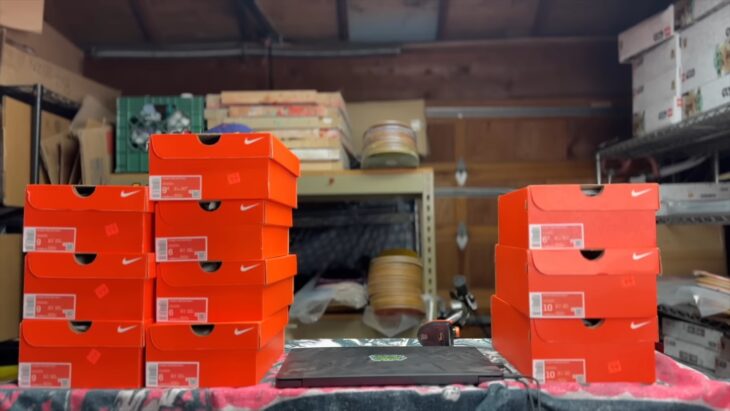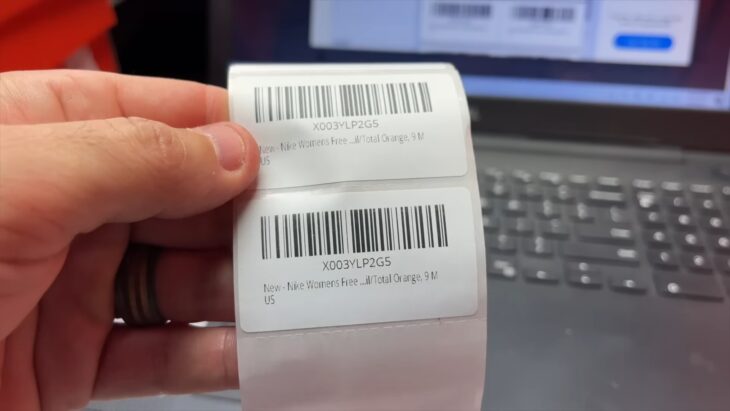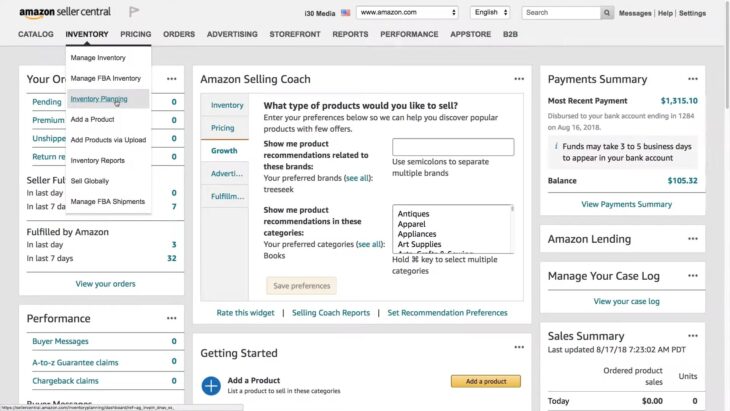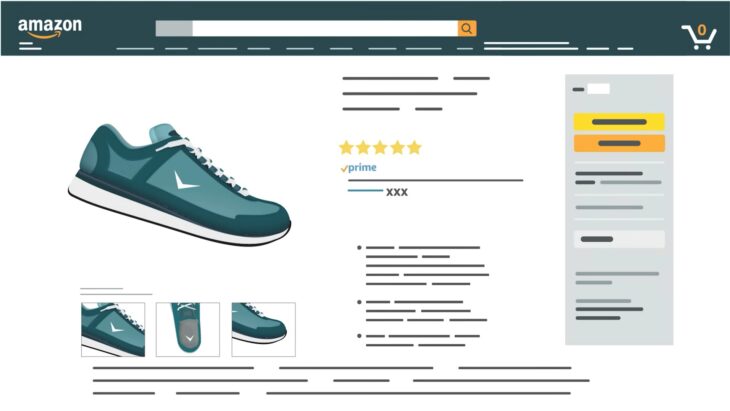The integration with Amazon’s extensive fulfillment network has streamlined our product distribution, allowing us to focus more on product development and customer engagement. The reliability and varied shipping options offered by Rapid Express Freight have significantly reduced the instances of order cancellations, and their competitive rates for expedited deliveries have enhanced our ability to offer prompt service to our customers.
If you want to find out more about how this service can help your business, we will share more details in the following sections.
Table of Contents
ToggleA Business Must Follow These 6 Steps
| Step | Task | Description |
|---|---|---|
| 1 | Product Preparation | Ensure products are ready for shipment, including correct labeling and packaging. |
| 2 | Select Shipping Service | Choose the most suitable transportation mode (truckload, LTL, train freight, air freight). |
| 3 | Labeling and Documentation | Apply adequate labeling and complete the bill of lading. |
| 4 | Arrange Shipment Collection | Contact Rapid Express Freight for pickup and provide detailed shipment information. |
| 5 | Monitoring and Tracking | Use Rapid Express Freight’s tracking services to monitor shipment status. |
| 6 | Handling Returns and International Shipping | Manage international returns and expand your business globally. |
1. Product Preparation

To use Amazon FBA Rapid Express Freight in the right way, businesses should prepare their products carefully. This helps them ship faster and avoid problems at Amazon’s warehouses.
Packaging Standards
The initial focus is on proper packaging. This means selecting the right size and type of packaging for each product, ensuring it’s secure, and minimizing the risk of damage during transit.
For fragile items, additional padding or sturdy boxes are essential. We’ve learned that investing in quality packaging pays off in the form of fewer customer complaints and returns.
Proper packaging can reduce shipping damages by up to 80%, significantly impacting customer satisfaction and reducing returns.
Labeling Accuracy
Each product must be labeled correctly. This includes clear and accurate product identification, barcodes, and any other required information by Amazon.
We double-check each label for legibility and accuracy to prevent any delays or misplacements during the sorting process at the fulfillment centers.
Compliance with FBA Requirements
Amazon FBA has specific requirements for products sent to their fulfillment centers. It’s vital to familiarize yourself with these requirements, which can include specifications on labeling, packaging materials, and item size.
In our experience, ensuring compliance beforehand has been a key factor in avoiding unnecessary delays or additional fees.
Quality Control
Before shipping, conducting a final quality check is a step we never skip. This involves inspecting the items for any defects or damage and ensuring that the product matches the description and quality standards expected by the customers.
Consistent quality control maintains high customer satisfaction and positive reviews.
2. Select Shipping Service
When using Amazon FBA Rapid Express Freight, selecting the right shipping service is a key step that significantly impacts the efficiency and cost-effectiveness of your deliveries. Here’s a guide to assist businesses in making this crucial decision:
Transportation Modes
Rapid Express Freight offers various modes of transportation, including truckload, less-than-truckload (LTL), train freight, and air freight. Each mode has its benefits and is suitable for different types of shipments. For instance, air freight is faster but more expensive, while truckload shipping is cost-effective for larger shipments.
Delivery Requirements
Consider the urgency of your delivery and the type of goods being shipped. If you need fast delivery across long distances, air freight might be the best option.
For less urgent shipments, truckload or train freight could be more economical.
On the other hand, determining your own return policy as a business that collaborates with Amazon is also very important.
Cost
Compare the costs of different shipping options. While some methods may offer quicker delivery, they might also be more expensive.
It’s important to balance speed with cost to find the most efficient solution for your business needs.
Volume and Weight of Shipments
The size and weight of your shipment can also influence your choice of shipping service. Larger, heavier shipments might be more suited to truckload or train freight, whereas smaller, lighter packages could be more cost-effective with LTL or air freight.
Destination
Some destinations might be more easily accessible by certain modes of transport. For example, if your shipment needs to reach a remote location, truck freight might be the only viable option.
Tracking
Ensure the shipping service you choose offers reliable tracking and delivery. Timely and accurate tracking can be crucial for managing customer expectations and ensuring satisfaction.
Effective package tracking can increase customer satisfaction by over 70%, as it enhances transparency and builds trust in the delivery process.
3. Labeling and Documentation

The step of labeling and documentation is critical for ensuring that your shipments are processed smoothly and reach their destination without any hiccups. This stage involves several key components:
Accurate Labeling
Each item being shipped must be labeled accurately. This includes ensuring that product labels match the details provided in your Amazon Seller Central account.
Proper labeling is essential for correct sorting and delivery at Amazon’s fulfillment centers.
Barcode Requirements
Amazon requires barcodes on products to efficiently track and manage inventory. These barcodes should conform to Amazon’s standards and be placed visibly on the product packaging.
Completing the Bill of Lading
The bill of lading is a vital document in shipping logistics. It acts as a receipt for the goods shipped and a contract between the shipper and the carrier.
It should detail what is being shipped, the freight class, and both the shipper’s and receiver’s (consignee’s) information.
It is essential in legal disputes, as it precisely outlines the terms of shipment and responsibility.
Additional Documentation
Depending on the nature of your products and the destination, additional documentation such as invoices, packing lists, or special handling instructions may be required. Ensure all necessary paperwork accompanies your shipment.
Consistency in Information
The information on your labels and documents must be consistent and match what’s registered in your Amazon Seller Central account. Inconsistencies can lead to delays or misplacement of your shipments.
Visibility of Labels
Labels should be placed in a manner that is easily visible and scannable. This helps in efficient processing at Amazon fulfillment centers and reduces the chances of delays or errors.
Follow Amazon’s Guidelines
Familiarize yourself with Amazon’s specific labeling and documentation guidelines. Adhering to these guidelines can prevent a range of logistical challenges and delays.
4. Arrange Shipment Collection
After properly preparing and documenting your products, the next step is to arrange for the collection of your shipment.
Contact Rapid Express Freight
Once your products are ready for shipment, reach out to Rapid Express Freight. This can typically be done through their website, over the phone, or via a dedicated platform if provided.
Provide Detailed Information
When arranging for collection, be precise and thorough with the information you provide. This includes details about the nature of the goods, the total number of boxes or pallets, the weight and dimensions of each package, and any special handling instructions.
Schedule a Pickup Time
Coordinate a suitable pickup time that aligns with your business operations. Ensure that your shipment is ready for collection at the scheduled time to avoid delays.
Confirm Transportation Mode
Depending on the size and urgency of your shipment, confirm the mode of transportation with Rapid Express Freight, be it air, truck, rail, or sea freight.
Reconfirm Details
It’s always a good practice to reconfirm the details of the shipment a day before the scheduled pickup. This includes checking the destination address, estimated delivery time, and any tracking or reference numbers.
Keep Records
Maintain a record of the transaction, including the bill of lading, contact details of the carrier, and any tracking numbers. This information is crucial for tracking your shipment and addressing any issues that may arise during transit.
Thorough records in shipping can improve dispute resolution efficiency by up to 50%. Accurate documentation is key in quickly addressing any transit issues or claims.
Prepare for Pickup
Ensure that your shipment is properly packaged, labeled, and ready for transport to avoid any delays during the pickup. The goods should be accessible and safely positioned for efficient loading.
5. Monitoring and Tracking

Once your shipment is on its way, the next step is monitoring and tracking its progress. It is crucial for maintaining transparency and managing expectations for both your business and your customers.
Use the Right Tracking Tools
Rapid Express Freight typically provides tracking tools or services. Utilize these tools to keep a close eye on the whereabouts and status of your shipment.
This information is often accessible through the carrier’s website or a customer portal.
Advanced tracking tools can increase logistical efficiency by over 60%. Tools like GPS tracking and real-time updates have revolutionized the way businesses manage and monitor their shipments.
Stay Informed
Regularly check the status of your shipment. This proactive approach allows you to stay informed about any delays or issues that might arise during transit.
Communicate with Rapid Express Freight
In case of any discrepancies or if the tracking information is not updated, don’t hesitate to contact Rapid Express Freight’s customer support. They can provide more detailed insights into the status of your shipment.
Stay in Touch with Customers
If you’re anticipating any delays or changes in the delivery schedule, it’s important to communicate this to your customers promptly. This helps in managing their expectations and maintaining a good customer relationship.
Keep the Records
Keep a record of all tracking information and communications regarding your shipment. This can be useful for future reference, especially if any disputes or claims arise.
Analyze Transit Times
Use the tracking data to analyze the transit times and efficiency of different shipping routes or methods. This analysis can be valuable for future shipping strategy and logistics planning.
Use Amazon’s Tools
If you are an Amazon seller, you can also leverage tools provided by Amazon for additional insights and tracking of your inventory once it reaches their fulfillment centers. That is one of the key tools that will help you.
6. Handling Returns and International Shipping

Businesses must be prepared to handle returns and manage international shipping effectively. These aspects are crucial for maintaining customer satisfaction and ensuring a smooth global operation.
Returns Management
- Streamlining Returns: Establish a clear and efficient process for handling returns. This includes setting up a system for receiving returned goods and inspecting them for damages or other issues.
- Reshipping Solutions: Consider using services like Reship for managing returns, which can simplify the return process for international orders.
- Communication with Customers: Keep your customers informed throughout the return process. Transparency in communication can enhance customer trust and satisfaction.
Efficient returns management can lead to a 25% increase in customer retention.
International Shipping
- Regulations: Be aware of and comply with the customs regulations and import/export requirements of the countries you are shipping to. This is crucial to avoid delays and legal issues.
- Cultural and Market Differences: Recognize and adapt to the cultural and market differences in various regions. This includes understanding local consumer behavior, preferences, and return policies.
- Optimized Logistics: Choose the most appropriate and cost-effective transportation modes for international shipping. This may involve a combination of air, sea, and land freight depending on the destination and type of goods.
Implement the Amazon’s Global Reach
- Amazon’s International Fulfillment Centers: Take advantage of Amazon’s global network of fulfillment centers to store and ship products closer to international customers. This can reduce shipping costs and delivery times.
- Global Inventory Management: Monitor and manage your inventory across different locations to ensure availability and timely fulfillment of international orders.
Customer Service for International Orders
- Local Support: Provide customer support that caters to the language and time zones of your international customers.
- Customs and Duties: Be transparent with customers about any additional customs duties or taxes they might need to pay on international orders.
FAQs
Can you make a living selling on Amazon?
Yes, it is possible to make a living selling on Amazon. Many sellers have found success by offering unique products, understanding their market, and effectively managing their Amazon operations. The goal is to choose the right products that you will sell. You can combine it with other platforms. A lot of people are using international e-commerce platforms like Temu and Alibaba.
Is a 30% profit margin good for Amazon?
A 30% profit margin is generally considered good on Amazon. It’s above average for many retail industries and can indicate healthy profitability, but it’s important to also consider other factors like volume and competition.
How much stock do you need for FBA?
The amount of stock needed for Amazon FBA depends on your product’s demand, sales velocity, and your supply chain’s responsiveness. It’s wise to have enough stock to cover at least a month’s sales, but not so much that it ties up unnecessary capital or incurs high storage fees.
Can I start Amazon FBA with no money?
Starting Amazon FBA with no money is challenging. Initial costs include inventory, shipping, and Amazon fees. However, low-cost strategies like dropshipping or arbitrage might offer a starting point with minimal upfront investment.
Last Words
Amazon FBA Rapid Express Freight can be a game-changer for your business. It offers a pathway to efficiently manage your logistics, expand your reach, and ultimately contribute to the growth and success of your enterprise.
However, it is crucial to understand that this is a complex process and that you will have to pay attention to all details.



